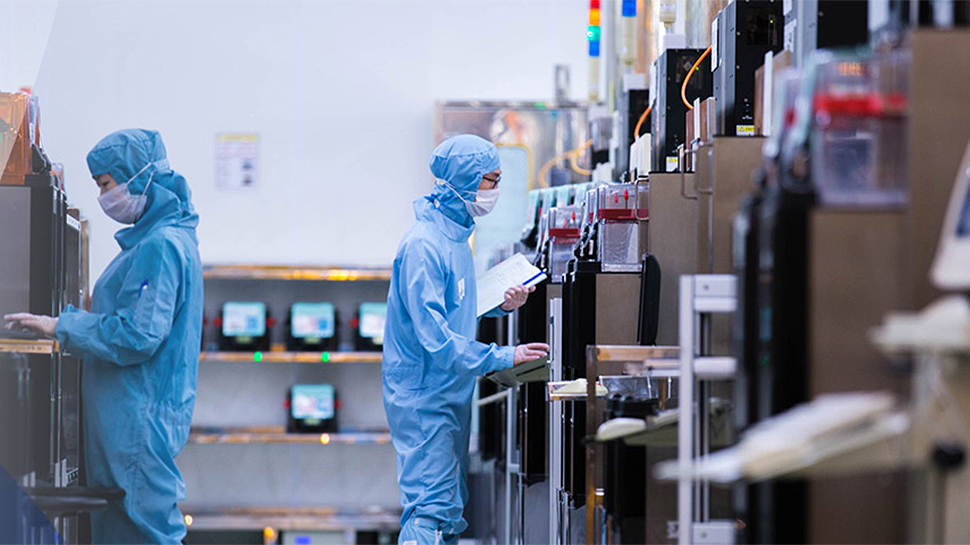China's aggressive push to develop a domestic semiconductor industry has largely been successful. The country now has fairly advanced fabs that can produce logic chips using 7nm-class process technologies as well as world-class 3D NAND and DRAM memory devices. However, there are numerous high-profile failures due to missed investments, technical shortcomings, and unsustainable business plans. This has resulted in numerous empty fab shells — zombie fabs — around the country, according to DigiTimes.
As of early 2024, China had 44 wafer semiconductor production facilities, including 25 300-mm fabs, five 200-mm wafers, four 150-mm wafers, and seven inactive ones, according to TrendForce. At the time, 32 additional semiconductor fabrication plans were being constructed in the country as part of the Made in China 2025 initiative, including 24 300-mm fabs and nine 200-mm fabs. Companies like SMIC, HuaHong, Nexchip, CXMT, and Silan planned to start production at 10 new fabs, including nine 300-mm fabs and one 200-mm facility by the end of 2024.
Plenty of zombie fabs
However, while China continues to lead in terms of new fabs coming online, the country also leads in terms of fab shells that never got equipped or put to work, thus becoming zombie fabs. Over the past several years, around a dozen high-profile fab projects, which cost investors between $50 billion and $100 billion, went bust.
Swipe to scroll horizontally
Name | Purpose | Investment | Status | Location |
Dehuai Semiconductor | Analog and mixed-signal ICs IDM | $3 billion | Bankrupt, assets auctioned off | Guiyang, Guizhou |
Fujian Jinhua Integrated Circuit (JHICC) | 300-mm DRAM fab with a 60,000 wafer starts per month | $5.6 billion | Blacklisted by U.S. government; stole trade secrets from UMC; failed to develop DRAM process node | Jingiang, Fujian |
GlobalFoundries Chengdu Fab | Logic chip foundry | $1 billion - $10 billion | Revived by Shanghai Huali Microelectronics (HLMC) | Chengdu, Sichuan |
Jiangsu Advanced Memory Semiconductor (AMS) | Phase-change memory (PCM) fab; 100,000 300-mm wafers/year | $1.8 billion | Bankrupt; restructuring deal failed; searching for new investors | Huaian, Jiangsu |
Huaxin Jiechuang Integrated Circuits Manufacturing | Convert AMS into a multi-service foundry | $2.8 billion | Failed to transfer funds; deal terminated | Huaian, Jiangsu |
Jiangsu Zhongjing Aerospace | Two 200-mm CMOS Image Sensor (CIS) fabs | ? | Failed to launch; no progress has been made beyond PowerPoint presentation | Jiangsu (exact city unspecified) |
Hongxin Semiconductor Manufacturing Co. (HSMC) | 14nm/7nm logic with ASML lithography equipment | $19 billion | Ran out of funds; site abandoned with unfinished buildings | Wuhan, Hubei |
Huaian Imaging Device Manufacturer (HiDM) | CMOS Image Sensor (CIS) fab | $6.3 billion | Stalled; fab never completed | Huaian, Jiangsu |
Quanxin Integrated Circuit Manufacturing (QXIC) | 12nm/14nm logic fab | ? | Cancelled in 2021 | Wuhan, Hubei |
Tacoma Semiconductor | CMOS Image Sensor (CIS) fab | $3 billion | Collapsed in 2020; leadership disappeared | Nanjing, Jiangsu |
Tsinghua Unigroup 3D NAND project | 3D NAND fab to replicate success of YMTC | $24 billion | Scrapped after Tsinghua Unigroup missed debt payment deadlines | Chengdu, Sichuan |
Tsinghua Unigroup DRAM project | DRAM fab | ? | Chengdu, Sichuan Province | Chongqing |
Many Chinese semiconductor fab projects failed due to a lack of technical expertise amid overambitious goals: some startups aimed at advanced nodes like 14nm and 7nm without having experienced R&D teams or access to necessary wafer fab equipment. These efforts were often heavily reliant on provincial government funding, with little oversight or industry knowledge, which lead to collapse when finances dried up or scandals emerged. Some fab ventures were plagued by fraud or mismanagement, with executives vanishing or being arrested, sometimes with local officials involved.
To add to problems, U.S. export restrictions since 2019 blocked access of Chinese entities to critical chipmaking equipment required to make chips at 10nm-class nodes and below, effectively halting progress on advanced fabs. In addition, worsening U.S.-China tensions and global market shifts further undercut the viability of many of these projects.
So, let's go over some of China's most ambitious fab projects, many of which have fallen into oblivion, or have become a dreaded zombie fab.
Failures to learn from
Leading chipmakers, such as Intel, TSMC, Samsung, or SMIC have spent decades developing their production technologies and gain experience in chips on their leading-edge nodes. But Chinese chipmakers Wuhan Hongxin Semiconductor Manufacturing Co. (HSMC) and Quanxin Integrated Circuit Manufacturing (QXIC) attempted to take a shortcut and jump straight to 14nm and, eventually, to 7nm-class nodes by hiring executives and hundreds of engineers from TSMC in 2017 – 2019.
HSMC was founded in late 2017 with a plan to build 14nm and 7nm-capable logic fabs in Wuhan with an initial investment of around $19 billion. However, a land-use dispute halted construction in November 2019, and by mid‑2020, it suffered severe underfunding of billions of dollars. By March 2021, the local government seized the project, fired all employees, and confirmed no chip production had ever occurred.
QXIC similarly aimed at 14nm-class production when it was founded in 2019 as a sister venture to HSMC in Jinan, Shandong. The company was born after issues with HSMC occurred. Despite government backing, the project never progressed beyond hype: there were no equipment orders, no factory construction, and by 2021, operations were suspended. Interestingly, Cao Shan, who served as chief executive of QXIC, was also a former board member of HSMC.
Perhaps, the most notorious China fab venture failure — the first of many — is GlobalFoundries' project in Chengdu. GlobalFoundries unveiled plans in May 2017 to build an advanced fabs in Chengdu in two phases: Phase 1 for 130nm/180nm-class nodes and Phase 2 for 22FDX FD-SOI node. The company committed to invest $10 billion in the project, with about a billion invested in the shell alone.
Financial troubles forced GlobalFoundries to abandon the project in 2018 (the same year it ceased to develop leading-edge process technologies) and refocus to specialty production technologies. By early 2019, the site was cleared of equipment and personnel, and notices were issued in May 2020 to formally suspend operations.
The site and unfinished building remained uninhabited for five years before Shanghai Huali Microelectronics Corp. (HLMC), controlled by the Hua Hong Group, announced it would take over the dormant site in mid-2023. HLMC is one of a few Chinese companies that intend to develop a sub-10nm-class fabrication process. However, it is unclear whether the Chengdu fab will be used as its flagship facility. GlobalFoundries’ Chengdu project serves as a rare example of a recovery among China’s stalled semiconductor projects. A rare exception to the numerous failures that China has encountered thus far.
Dehuai Semiconductor, an analog and mixed signal IDM startup, was not so lucky. The company was launched in 2019 with the help of local authorities. Dehuai did not present a clear roadmap, and made false claims about how its project was proceeding. By mid-2021, local anti-corruption authorities arrested key executives after investigations revealed that no fab had been built: only initial site preparation had begun. The project was one of the most notorious examples of fraud and mismanagement among China’s failed semiconductor ventures.
The fate of Fujian Jinhua Integrated Circuit (JHICC) is a bit different. Formally, this is not a failed project, but it is not a living one either. JHICC was launched with an ambition to build China's first large-scale DRAM fab in 2016. The company magically began trial production about two years after its inception, but it was soon discovered that it had stolen process technology from Micron using the help of UMC. Eventually, the U.S. Commerce Department put Fujian Jinhua into its Entity List, cutting its access to any American technology. This essentially stops the development of new process technologies and bans the procurement of any advanced tools. As a result, while JHICC has formally survived and exists on paper, it is a spectre of its former ambitions.
Another memory project that has failed in China is Jiangsu Advanced Memory Semiconductor (AMS). The company was established in 2016 with the plan to lead China's efforts in phase-change memory (PCM) technology. The company aimed to produce 100,000 300-mm wafers annually and attracted an initial investment of approximately $1.8 billion. Despite developing its first in-house PCM chips by 2019, AMS ran into financial trouble by 2020 and could no longer pay for equipment or employee salaries. It entered bankruptcy proceedings in 2023, and while a rescue plan by Huaxin Jiechuang was approved in 2024, the deal collapsed in 2025 due to unmet funding commitments.
Producing commodity types of memory is a challenging business. Tsinghua Unigroup was instrumental in developing Yangtze Memory Technology Co. and making it a world-class maker of 3D NAND. However, subsequent 3D NAND and DRAM projects were scrapped in 2022, after the company faced financial difficulties one year prior.
Tsinghua Unigroup’s second 3D NAND project aimed to mirror YMTC's model. But, at the time, even YMTC itself was still far from challenging multinational 3D NAND makers. So, the logic of building another costly fab (potentially reaching $24 billion) and possibly developing a new 3D NAND process technology was questionable.
For its DRAM efforts, Tsinghua brought in former Elpida CEO Yukio Sakamoto, who had experience competing with Samsung and Micron. However, he left in 2021 as Tsinghua approached bankruptcy, before he could contribute. Given the years and billions needed to develop DRAM technology — compounded by tool supply risks — Tsinghua scrapped its DRAM ambitions.
Logic and memory require rather sophisticated process technologies, and fabs that cost billions. By contrast, CMOS image sensors (CIS) are produced using fairly basic production nodes and on relatively inexpensive (yet very large) fabs. Nonetheless, this did not stop Jiangsu Zhongjing Aerospace, Huaian Imaging Device Manufacturer (HiDM), and Tacoma Semiconductor from failing. None of their fabs have been completed, and none of their process technologies have been developed.
China's failures could come back to haunt future ambitions
China's wave of semiconductor production companies' failures highlights a fundamental reality about the chip industry: large-scale manufacturing requires more than capital and ambition. Without sustained expertise, supply chain depth, and long-term planning, even the best-funded initiatives can quickly fall apart. These deep structural issues in the People's Republic's semiconductor strategy will continue to hamper its progress for years to come before the fundamental issues will be solved.
Follow Tom's Hardware on Google News to get our up-to-date news, analysis, and reviews in your feeds. Make sure to click the Follow button.

 4 months ago
75
4 months ago
75






 English (US) ·
English (US) ·